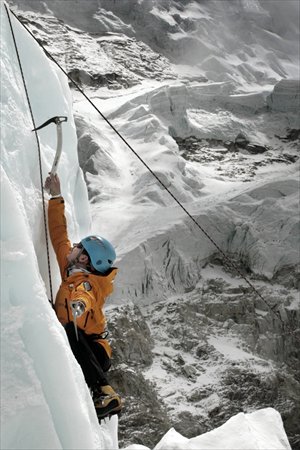HOME >> LIFE
Reaching the top
Source:Xinhua Published: 2014-4-1 21:38:03

A climber trains to summit Qomolangma. Photo: CFP
With the spring climbing season just around the corner, Lila Bahadur Basnet, a 30-year-old Nepali climber, is about to set a new world record by reaching the summit of Mount Qomolangma, commonly known in the West as Mount Everest, and making it back to Kathmandu within 10 days.In an interview with the Xinhua News Agency, Basnet said that in 2009 it took him just eight days to climb and descend but that was because he had to rush back after he got a call that his 2-year-old son was admitted to the hospital.
"Now, I am confident that I will set a new world record under normal circumstances," Basnet said.
Besides setting a new world record, Basnet wishes to drum up support for the campaign against human trafficking in South Asia.
With the slogan "Humans not for sale," Basnet will raise awareness on issues related to human trafficking right from the rooftop of the world.
His wish is to hand over a jacket with more than 200 flags from different countries sewed on it to Ban Ki-moon, United Nations secretary general, if he is given the chance to visit the UN headquarters in New York.
Having a total of nine years of mountaineering experience, Basnet has successfully ascended the 8,848-meter mountain four times already. The first time he reached Mount Qomolangma's summit was eight years ago coinciding with the birth of his son that same year.
This spring climbing season, he wants to make it back to Nepal's capital city to commemorate Tenzing and Hillary's first ascent to Mount Qomolangma which is observed every May 29. The first ascent to Mount Qomolangma was on May 29, 1953.
"Climbing to the world's highest peak from Kathmandu usually takes weeks allowing for proper altitude acclimatization," Temba Tsheri, the youngest Qomolangma climber as per the Guinness Book of World Records, told Xinhua.
Expeditions from the south side of Qomolangma in Nepal fly into Lukla from Kathmandu and pass through Namche Bazaar, popularly known as the "gateway to Everest."
Climbers then hike to Base Camp at 5,380 meters, which usually takes six to eight days to prevent altitude sickness.
From there, it takes weeks before one can reach the summit passing through four intermediate camps.
Basnet's record-breaking climb will be followed step by step by a professional film crew. A documentary, entitled Everest: Beyond the Record by Film Himalaya, will be released next year.
Basnet confided that his life has been an uphill battle, metaphorically speaking just like climbing a steep mountain. When he was just 12 years old, both his parents died forcing him to start working at a very young age.
"My mother died of cancer. I never completed my studies and I started working in the field when I was only 8 years old," Basnet said.
He grew up in Dholka, a hilly region located in the mid-western region of the Himalayan nation. His caste is not usually associated with mountaineering.
Basnet said that he got his first job as a guide through his wife who belongs to the Sherpa people, renowned in the international climbing community for their experience at very high altitudes making them expert guides and porters for foreign mountaineers.
"I prefer working as a climber as you are master of your own destiny whereas businesses are constantly influenced by external factors," he said.
Basnet started working as a cook for high-mountain expeditions before becoming a trekking porter and then a so-called "climbing Sherpa." When asked what scares him the most, he said the Khumbu icefall, regarded by many as Mount Qomolangma's "death trap."
"I do not want my son to grow up without a father like me but we never know what will happen on the mountain," Basnet said philosophically.
Around 3,500 people have reached the top of Mount Qomolangma since the first conquest in 1953. The summit climbing season usually starts in late April every year.
Posted in: Miscellany